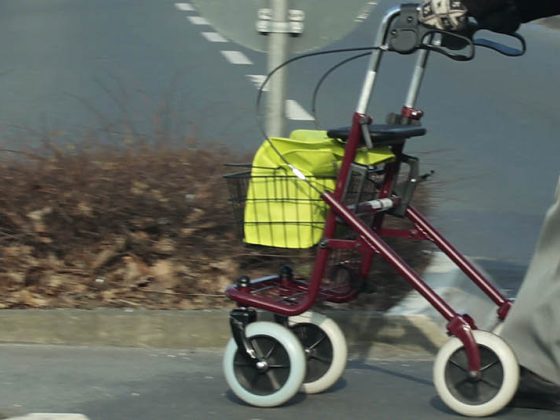At the Multiple Sclerosis Symposium in Bern, experts took a close look at current symptomatic and disease-modifying therapy. With the rapid advances made in recent years, it is important to remember that adherence remains a central pillar of MS treatment. In addition, risk markers and predictors of poor long-term outcome need to be found. How useful is the NEDA concept for clinical practice? In symptomatic therapy, there are still many open questions, but also developments that give hope. For example, experimental approaches are attempting to incorporate vitamin D into cortisone boost therapy to improve response.
Prof. Dr. med. Andrew Chan, new head of the University Outpatient Neurocenter (ANZ) at the Inselspital Bern, addressed benefit-risk considerations in current MS therapy: “Currently, we have many therapy options that differ in terms of their activity, but of course also their safety profile. In our decision for a certain drug, guidelines, approvals, economic aspects and also the sometimes serious side effects play a central role. Nevertheless, the choice remains challenging given the heterogeneity of the disease and the sometimes difficult translation of study data into clinical practice.” The goal must be an activity/phase-adapted therapy whose likely benefit exceeds the risk. But this is easier said than done: For one thing, there is often no direct comparison between the therapeutic agents, and long-term data on efficacy and safety have yet to be collected with the newer agents. Second, adherence is critical to benefit, as shown in a 2010 retrospective study [1]. Only just 4% of the 1606 MS patients treated with interferon-β were adherent over three years, i.e., had a Medication Possession Ratio (MPR) ≥85%. Participants with poor adherence had a higher relative risk of relapse, hospitalization, or emergency presentation during the three-year study period.
Long-term Outcome
“Overall, approximately one-third of patients with relapsing-remitting MS (RRMS) appear to experience one or more relapses within a year despite first-line therapy, according to retrospective real-life data [2],” he said. In other studies, after ten years, just 9% reach a so-called “no evidence of disease activity” (NEDA 3) [3], which is defined by three parameters: absence of relapses, absence of EDSS progression, absence of MRI activity (in NEDA-4, brain atrophy is added as a parameter). The question now is: Is this actually significant? How relevant are the individual factors actually to long-term outcome? A study group from Spain was able to show that a relapse within one year probably does not relevantly increase the probability of an increase of at least two points on the Expanded Disability Status Scale (EDSS) after eight years. In contrast, the following factors had been shown to be 1-year predictors: ≥1 point on the EDSS (hazard ratio 2.4), new active lesions (HR 2.1), ≥3 new T2 lesions (HR 2.9), ≥1 gadolinium-enhancing lesion (HR 2.1), 1 thrust plus 1 gadolinium-enhancing lesion (HR 3.5), Rio score (HR 3.3). “It should be noted that these data were collected in a substance-specific (interferon-β) manner and, of course, require independent validation,” the speaker indicated.
Another question is: Does NEDA really capture everything we need to know? For example, the factor “cognitive impairment” is also related to EDSS progression. If cognition deficits are found in newly diagnosed RRMS, the probability of an EDSS score of at least 4 after ten years is increased more than threefold according to studies (HR 3.18; p<0.001) [4]. “Freedom from disease activity” is useful as a concept in principle, since it reminds us again and again to review and, if necessary, adjust therapy. It represents a goal to which we can initially orient ourselves. However, constant re-evaluation is a very central point,” Prof. Chan explained.
In order to better assess the long-term risk of therapy, intensive research is currently being conducted on risk markers. At last year’s ECTRIMS, data on dimethyl fumarate showed: Early lymphopenia, defined as a decreased lymphocyte count in the first year of therapy <500/µl, increases the risk of remaining as significantly lymphopenic persistently (>6 months) [5]. A possible monitoring algorithm under dimethyl fumarate could be:
- a clinical examination every three months
- an initial MRI
- In the first year: differential blood count six to eight weeks, then three months.
Grade 3 lymphopenia should be discontinued, and grade 2 should be followed by a four-week differential blood count. “With nonvalidated biomarkers, such as lymphocyte subpopulations or anti-JCV antibodies under dimethyl fumarate or fingolimod, clinical vigilance is basically always indicated,” Prof. Chan cautioned.
Symptomatic therapy
Thrust therapy: Christian Kamm, M.D., Senior Physician at the University Department of Neurology at the Inselspital in Bern, spoke about the treatment of relapses, among other things: High-dose glucocorticoid therapy is carried out with Solu-Medrol®, either i.v. 500 mg/d for five days with peroral tapering (prednisone three days each of 100, 50, 25, and 12.5 mg) or i.v. 1000 mg/d for three days without peroral tapering. If severe symptoms persist despite the above therapy, an extension of i.v. methylprednisolone administration (1 g/d) to a maximum of ten days is possible. If symptoms are still unchanged after one to two weeks, an additional 2 g/d for five days is advised. If the situation has still not improved after another two weeks, the only options are plasmapheresis (PE) or immunoadsorption (IA) for five to six cycles. “Initial steroid therapy has been given under inpatient conditions resp. Monitoring to be done. Intravenous methylprednisolone can be replaced by oral Medrol® at equivalent doses [6],” the expert explained. “Calcimagon D3® and gastric protection (PPI) should be used during therapy, and blood glucose checks should be performed.”
Spasticity: “In addition to physiotherapeutic approaches, drug treatment is available, for example, Baclofen per os (Lioresal®), Tizanidinum per os (Sirdalud®) or newly the cannabis preparation Sativex® is available. I think the latter works well, but it’s only available through a cost-sharing arrangement, so the insurance company doesn’t have to cover it.” Also, with intramuscular Botox injections (Dysport®), good results have been achieved in randomized controlled trials [7]. In refractory immobile patients, an intrathecal Baclofen® pump is a possible option.
Fatigue: “Here, in my experience, drug therapy, e.g. with amantadine (PK-Merz®), SSRIs or modafinil, is still rather disappointing,” Dr. Kamm noted. More effective are chronohygiene (managing energy via break management, naps, etc.), aerobic endurance training (ergometer, treadmill), and cooling with air conditioners, cold showers, and wearing cooling vests/pants.
Cognitive deficits: “With regard to cognition disorders, there is also no certain evidence that medication works. This makes non-drug therapy all the more important,” he said. Possible approaches include disorder-specific cognitive training, teaching compensatory strategies, or even a game-based approach such as cognifit.com. Adjunctive psychotherapy and family counseling are other options that should be explored.
Micturition problems: Micturition difficulties may be an initial symptom of MS. At the latest in the long-term course of the disease, however, the frequency then increases sharply again, which severely restricts the quality of life of those affected (see InFo NEUROLOGIE & PSYCHIATRIE 1/2016). Non-drug approaches include, first of all, behavioral therapy (micturition diaries, reduction of drinking quantity, etc.) and pelvic floor training with/without electrostimulation and EMG biofeedback. For residual urine volumes >100 ml, intermittent self-catheterization is an option. If this is not possible (e.g., due to cognitive deficits, severe visual impairment, or ataxia), suprapubic continuous drainage may be considered.
Nystagmus and tremor: “In this field, there are only experimental approaches so far,” he said. For the therapy of nystagmus, experiences with gabapentin (pendular nystagmus) [8] and 3,4-diaminopyridine (down-beat nystagmus) [9] or memantine exist.
For tremor, physical therapy or occupational therapy, among others, are used. “Deep brain stimulation can also be used to treat tremor, but is not a routine procedure and is reserved for special cases” commented Dr. Kamm. Overall, however, many questions remain unanswered. This also applies in particular to drug therapy. Conclusive recommendations are therefore not possible [10]. “Also effective in improving dexterity are standardized home-based training programs. We were recently able to show this in a study [11]”, says Dr. Kamm.
Combination therapy with vitamin D in MS?
Steroids and vitamin D show similar immunological effects (T-cell differentiation, cytokines, migration, etc.). Consequently, can vitamin D improve the efficacy of cortisone boost therapy? Robert Hoepner, MD, and colleagues, Neurological Clinic at St. Josef Hospital in Bochum, Germany, investigated this question in a previously unpublished study, the results of which were presented at ECTRIMS 2015 and elsewhere [12]. The researchers came to the following conclusion:
- Addition of vitamin D to methylprednisolone again significantly increased glucocorticoid-induced apoptosis of human T cells by 1.4-1.7-fold in vitro.
- Vitamin D dose-dependently increased glucocorticoid receptor expression on human T cells.
- Together, the two agents exerted positive synergistic effects on the course of MOG35-55 experimental autoimmune encephalomyelitis (EAE) in vivo.
- This synergistic effect was dependent on glucocorticoid receptor expression on T cells.
- Compared with patients with stable RRMS and those with a response to steroids during a relapse, significantly lower serum vitamin D levels were found in patients with steroid-resistant MS.
“Our results, if they can be confirmed prospectively, definitely have therapeutic relevance in steroid-resistant MS relapses. It may still be possible to achieve a response in these patients with vitamin D administration,” Dr. Hoepner suggested.
Source: Multiple Sclerosis Symposium, January 21, 2016, Bern
Literature:
- Steinberg SC, et al: Impact of adherence to interferons in the treatment of multiple sclerosis. A non-experimental, retrospective, cohort study. Clin Drug Investig 2010; 30(2): 89-100.
- Mäurer M, et al.: Health care situation of patients with relapsing-remitting multiple sclerosis receiving immunomodulatory therapy. A retrospective survey of more than 9000 German patients with MS. Eur J Neurol 2011 Aug; 18(8): 1036-1045.
- De Stefano N, et al: Long-term assessment of no evidence of disease activity in relapsing-remitting MS. Neurology 2015 Nov 10; 85(19): 1722-1723.
- Moccia M, et al: Cognitive impairment at diagnosis predicts 10-year multiple sclerosis progression. Mult Scler 2015 Sep 11. pii: 1352458515599075. [Epub ahead of print].
- Fox RJ, et al: Characterization of absolute lymphocyte count profiles in MS patients treated with delayed-release dimethyl fumarate: considerations for patient management. ECTRIMS 2015; Abstract P606.
- Le Page E, et al: Oral versus intravenous high-dose methylprednisolone for treatment of relapses in patients with multiple sclerosis (COPOUSEP). A randomised, controlled, double-blind, non-inferiority trial. Lancet 2015 Sep 5; 386(9997): 974-981.
- Hyman N, et al: Botulinum toxin (Dysport) treatment of hip adductor spasticity in multiple sclerosis. A prospective, randomised, double blind, placebo controlled, dose ranging study. J Neurol Neurosurg Psychiatry 2000 Jun; 68(6): 707-712.
- Averbuch-Heller L, et al: A double-blind controlled study of gabapentin and baclofen as treatment for acquired nystagmus. Ann Neurol 1997 Jun; 41(6): 818-825.
- Strupp M, et al: Treatment of downbeat nystagmus with 3,4-diaminopyridine. A placebo-controlled study. Neurology 2003 Jul 22; 61(2): 165-170.
- Mills RJ, Yap L, Young CA: Treatment for ataxia in multiple sclerosis. Cochrane Database Syst Rev 2007 Jan 24; (1): CD005029.
- Kamm CP, et al: Home-based training to improve manual dexterity in patients with multiple sclerosis. A randomized controlled trial. Mult Scler 2015 Oct; 21(12): 1546-1556.
- Hoepner R, et al: Key regulatory function of vitamin D for response to glucocorticosteroids in multiple sclerosis. ECTRIMS 2015; Abstract P1067.
InFo NEUROLOGY & PSYCHIATRY 2016; 14(2): 37-40.











